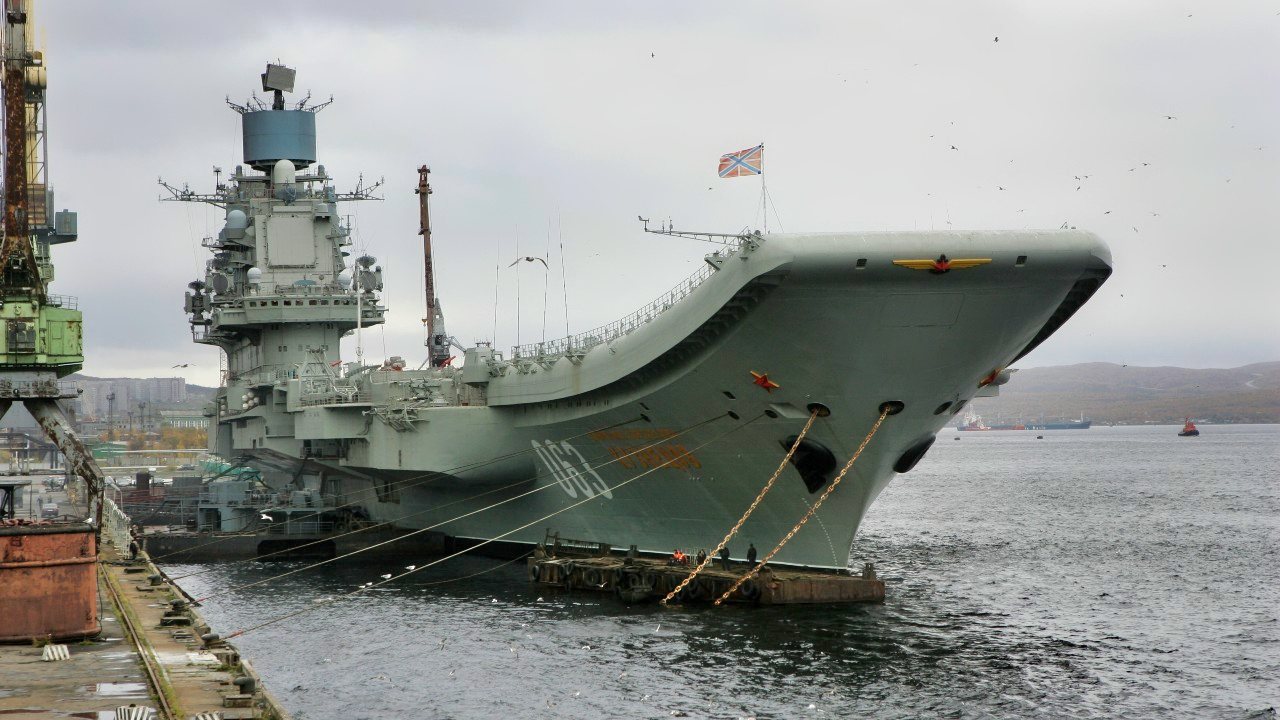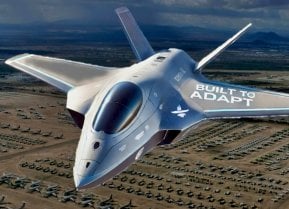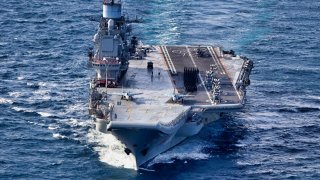Russia's Aircraft Carrier Dreams Turned Into a Never Ending Nightmare
Russia's struggles with aircraft carrier development stem from its historical focus on land power and the high costs associated with carrier construction.
5 Points You Need to Know: Russia's struggles with aircraft carrier development stem from its historical focus on land power and the high costs associated with carrier construction.
-During the Cold War, the Soviet Union prioritized tanks, nuclear missiles, and submarines over carriers, resulting in a limited naval aviation capability.
-The few carriers built, like the Moskva and Kiev classes, were not true carriers but hybrid designs.
-Post-Soviet Russia continued to face financial and technical challenges, leaving it with only one aging carrier, the Admiral Kuznetsov, which is often in need of repairs.
-Russia's lack of investment in carriers is attributed to resource allocation, engineering expertise, and budget constraints.
The Soviet Struggle with Aircraft Carriers: A Legacy of Missed Opportunities
Rubles, rubles, rubles, and the lack thereof. The Soviets never had enough money to build a large fleet of aircraft carriers during the Cold War, and Russia did not have enough money to build them after.
Russia has been more of a land power than a sea power throughout its modern history, and the dissolution of the Soviet Union ended ambitions to build more carriers to accompany the lone carrier Russia fields now, that cursed bucket of bolts, the Admiral Kuznetsov. The Kuznetsov is still all Russia has, and it is currently in dry dock for more repairs.
Aircraft Carriers: The Soviets Couldn’t Keep Up
The Soviets wanted to spend their money on tanks and nuclear missiles, plus submarines, destroyers, frigates, and cruisers – anything rather than carriers. There were plans throughout the 20th century for the country to build carriers, but they never gave life to a force that could help the Russians achieve dominance in naval aviation.
In 1962, the USSR started building two aircraft carriers at the Nikolayev shipyards in Ukraine. The two carriers, Moskva and Leningrad, were not full carriers. The fore of the ships looked like a guided-missile cruiser, and the aft half had a flight deck, a hangar, and an elevator. This was the Moskva-class, and these ships were mainly for anti-submarine warfare, with only a dozen helicopters for snooping and killing submarines. American nuclear subs were sneaking close to shore, and the Soviets needed an answer.
The next Soviet attempt at carrier-building was with the Kiev-class in the 1970s. The Soviets were worried that the Americans had the advantage in nuclear missiles and that their carriers would launch airplanes that could carry nuclear weapons. Russia needed their own carriers to go up against the U.S. Navy. Four Kiev carriers were built. What was notable about these ships is that they were equipped with a 350-kiloton anti-ship nuclear-capable cruise missile called the Sandbox. Thirty helicopters and a handful of Yak-38 VTOL fighters were deployed on the Kiev-class.
In the 1980s, the Soviets knew they had to keep up with the U.S. military build-up overseen by Ronald Reagan. They wanted to expand their navy with three carriers – two of 50,000 tons, and one that was to be nuclear-powered. This advanced model was going to be the supercarrier Ulyanovsk, and it was supposed to challenge the American Nimitz-class. Of those three carriers, only one was finished. The Ulyanovsk was canceled and later scrapped. Another was sold to China, and this vessel later became the Liaoning.
No Aircraft Carriers, Many Excuses
The Russian military always had an excuse not to build more aircraft carriers. Resource allocation was a commonly cited concern. National security depended on land forces and nuclear missile forces, especially during the 1980s, while the Americans were so greatly expanding defense programs and spending. By the time the USSR disbanded, there was no way Russia had the money to build any new carriers.

Engineering and design was a question too. Russia had some of the best personnel pursuing applied research in what we now call the STEM fields – science, technology, engineering, and mathematics. But the best of these practitioners were working on nuclear weapons and space exploration. The Russian military has misused its resources, and it did not invest in the human capital that could excel in shipbuilding, design, and engineering for new carriers.
Since the Kuznetsov was barely operational over the years, Russian naval aviation suffered. Russia lacked the platform needed to train the necessary number of pilots for a large force of aircraft that can be launched by a carrier.
Military planners had to ready land forces to protect Russia’s extensive borders, and the defense budget reflected this priority. The need to maintain a nuclear triad also pushed Russia to focus more on the design, building, and upkeep of boomer and attack nuclear submarines.
There just wasn’t the defense industrial base, monetary resources, and human expertise to manufacture modern carriers.
Expert Biography: Dr. Brent M. Eastwood
Dr. Brent M. Eastwood is the author of Humans, Machines, and Data: Future Trends in Warfare. He is an Emerging Threats expert and former U.S. Army Infantry officer. You can follow him on Twitter @BMEastwood. He holds a Ph.D. in Political Science and Foreign Policy/ International Relations.
All images are Creative Commons and/or Shutterstock.


